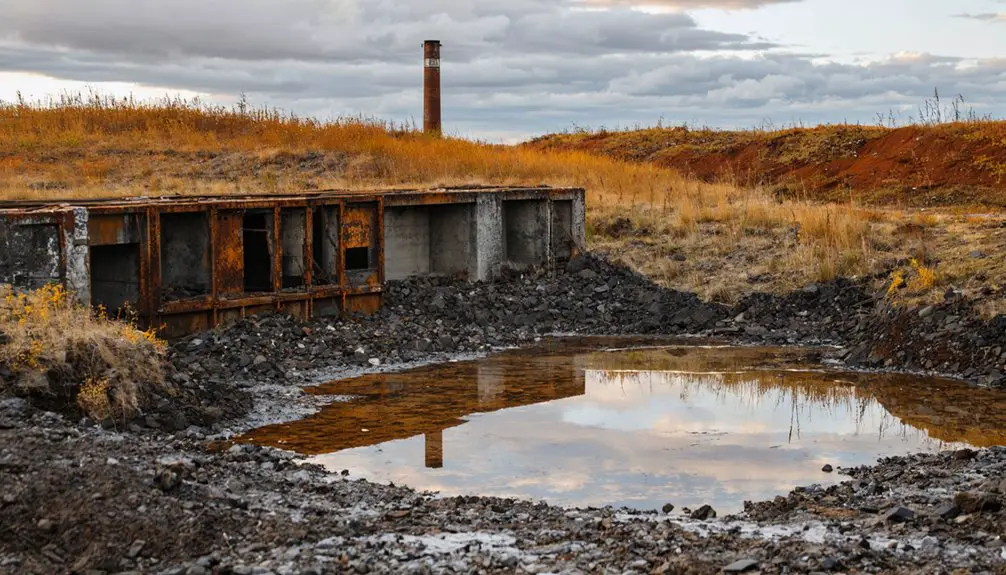You’ll find Mineral, Oklahoma’s stark transformation from a bustling mining town to an environmental disaster zone. In 1926, it emerged as the world’s largest source of lead and zinc, employing over 18,000 workers at its peak. The town’s mining operations generated over $20 billion in ore from 1917 to 1947, but toxic contamination led to its downfall. By 2009, EPA buyouts and evacuations turned this once-thriving community into a ghost town, leaving behind a complex legacy of prosperity and devastation.
Key Takeaways
- Mineral, Oklahoma became a ghost town in 2009 after severe environmental contamination forced federal buyouts and mass evacuation of residents.
- The town’s population plummeted from 14,000 in 1926 to approximately 20 people by 2010 due to mining-related health hazards.
- Toxic chat piles and contaminated groundwater from lead and zinc mining led to EPA declaring the area a Superfund site.
- Most buildings were demolished by 2011, leaving only select historic structures amid an ongoing environmental cleanup expected to last decades.
- The area was once the world’s largest source of lead and zinc, generating over $20 billion in ore from 1917 to 1947.
The Rise of Oklahoma’s Mining Frontier
As Oklahoma’s mining frontier emerged in 1872, coal mining quickly became the region’s dominant industry, initially concentrating in a 16-county area across the eastern territory.
You’ll find that early mining technology centered on underground shaft mining, which dominated operations through the 1960s in counties like Coal, Pittsburg, and Latimer. Surface mining equipment later revolutionized extraction methods.
The arrival of railroads between 1887 and 1902 transformed the region’s potential, sparking tremendous growth. The Missouri Kansas and Texas Railway established itself as the dominant transportation provider after 1872.
When the Choctaw Coal and Railway Company and the Chicago, Rock Island, and Pacific Railroad established their lines, they opened up new opportunities in Wilburton, Alderson, Hartshorne, and Coalgate.
Community resilience emerged as coal towns developed around these rail hubs, though they initially operated under the strict control of coal barons who established company stores and housing systems.
Excavation Operations and Economic Impact
You’ll find that Picher Field dominated the Tri-State Lead and Zinc District, generating over $20 billion in ore between 1917 and 1947 through its extensive room and pillar mining operations.
The mining industry’s explosive growth created jobs for more than 14,000 underground workers and 4,000 support staff, while fueling rapid urban development that saw the population surge to 14,000 by 1926. Similar to other place name disambiguation cases, multiple locations shared the Picher name during this era.
The field’s strategic importance peaked during World War I when it supplied over 50% of America’s lead and zinc resources, cementing its place as a vital mineral producer for the nation. The mining operations produced an astounding 130,000 tons of lead and 749,000 tons of zinc annually during peak production years.
Peak Production Years
During the early 20th century, Mineral, Oklahoma became a powerhouse of lead and zinc production, reaching its zenith in 1926 when the region emerged as the world’s largest source of these metals.
The economic boom transformed Ottawa County into a critical supplier during World War I, producing over half of America’s zinc and nearly half of its lead requirements.
You’ll find the most impressive numbers between 1908 and 1930, when the Tri-State District generated $222 million in zinc and $88 million in lead.
Mining technology advanced considerably in the late 1930s with the introduction of diesel equipment and mechanization, briefly extending peak production beyond the 1920s.
From 1891 to 1970, the area’s underground mines yielded an extraordinary 1.3 million tons of lead.
The industry reached its highest employment in 1924 with 11,187 workers contributing to the region’s remarkable output.
Economic Effects on Region
While extracting millions of tons of ore from beneath Mineral’s surface, mining companies employed a complex room-and-pillar technique that would ultimately seal the town’s fate.
You’d have found 248 mills operating simultaneously across 40-acre tracts, employing up to 14,000 residents during peak production from 1917-1947.
Despite generating over $20 billion in ore value, the region’s lack of economic diversification proved devastating when mining declined in the 1930s.
The EPA designated the area as a Superfund cleanup site in 1983 after decades of environmental degradation.
The Quapaw Tribe, who owned the land, received minimal benefits from unfair lease agreements while bearing the environmental burden.
By 1967, mine closures had triggered a population exodus, crushing community resilience.
Local creeks turned an alarming blood-red color from heavy metal contamination, devastating wildlife populations.
The toxic legacy of chat piles and contaminated groundwater continue to suppress property values and development opportunities, transforming this once-booming mineral hub into a ghost town.
Peak Mining Years and Community Growth
As Oklahoma’s coal industry emerged in 1872, its rapid growth transformed the eastern region of the state into a thriving mining hub.
You’d find production soaring from 1 million tons in 1891 to over 3.5 million tons by 1903, largely due to James J. McAlester’s strategic marriage into the Choctaw tribe and his railroad partnerships.
The community dynamics in mining towns reflected the industry’s dominance, with coal operators controlling local social structures through the use of company scrip for wages and purchases.
You’ll notice how these company-run towns, stretching from Lehigh to McCurtain, developed extensive infrastructure including 600-foot shafts and strip mining operations.
The Missouri, Kansas and Texas Railway played a vital role, connecting mines to markets and spurring rapid town development with commercial districts and public amenities emerging around mining activities.
The devastating Mine Number 11 explosion in 1892 claimed 87 lives and marked one of the region’s worst mining disasters.
Living Conditions and Daily Life
Living in Mineral, you’d have faced increasingly dangerous housing conditions as mine shafts beneath the town compromised building foundations, with 86% of structures deemed dangerously undermined by 2006.
Your daily routine would’ve included exposure to toxic chat pile dust containing lead and zinc, while essential services like schools continued operating despite the severe environmental hazards.
You’d have witnessed the gradual decline of town amenities and infrastructure as contaminated water, unstable ground, and chronic health risks forced many of your neighbors to accept government buyouts starting in the 1980s.
Housing and Living Spaces
During the town’s early development, housing in Mineral consisted primarily of modest wooden frame homes built hastily to accommodate the influx of mining families.
You’d find these simple shotgun-style houses and cottages packed tightly together near the mining operations, reflecting the working-class nature of the community.
As time progressed, housing deterioration became severe due to the town’s underlying mining caves.
Your home’s foundation could be compromised by ground subsidence, while toxic chat piles near residential areas contaminated everything from soil to interior spaces.
Despite these challenges, community resilience remained strong until environmental hazards became unbearable.
Work in Mining Community
While mining families sought steady work in Mineral, they faced grueling conditions that shaped every aspect of daily life.
You’d spend 10-12 hours underground performing dangerous extraction work, hauling coal, and loading railcars – often without pay for certain tasks. Mining labor wasn’t just physically demanding; it trapped you in a cycle of company control through scrip payments that left you indebted to company stores.
Your daily risks included deadly explosions, cave-ins, and exposure to toxic minerals. Despite using shale dust as a fire retardant, Oklahoma’s mines had some of the nation’s highest death rates.
Worker rights improved slightly after the 1903 watershed agreement and union strikes of 1894-1903, which fought against the oppressive company-town system. Still, seasonal work created constant economic uncertainty for mining families.
Town Services and Amenities
As Mineral’s population swelled with mining activity, basic amenities emerged to support the growing community.
You’d find company-built homes, general stores, saloons, and service shops catering to miners’ needs. The town maintained public schools, churches, and community gathering spaces that formed the heart of local social life.
Community services gradually declined as environmental problems took hold. You couldn’t ignore the toxic contamination that seeped into water supplies and soil, making basic utilities unsafe.
Local businesses shuttered as residents fled, and essential services vanished. The mining museum, which preserved the town’s heritage, was lost to fire.
Schools closed their doors as families relocated, and remaining structures fell into disrepair. By the time of federal buyouts, utility services had ceased entirely, leaving Mineral a ghost of its former self.
Decline of Mining Operations
Once Oklahoma’s mining industry reached its peak coal production of nearly six million tons in 1981, the sector began experiencing a sharp decline that would transform thriving communities into ghost towns.
You’ll find that several critical factors contributed to this transformation:
- Mining safety concerns escalated as room-and-pillar methods led to dangerous cave-ins, forcing closures of entire mining districts
- Economic sustainability became impossible when rising production costs collided with falling commodity prices, especially in copper and zinc sectors
- Environmental regulations and cleanup requirements in the 1980s made operations financially burdensome
Environmental Legacy and Health Effects

Since mining operations ceased in Mineral, Oklahoma, the town has grappled with a devastating environmental and health crisis stemming from toxic chat piles and contaminated mine water.
Abandoned mines left Mineral, Oklahoma a poisoned ghost town, its legacy marked by toxic waste and contaminated groundwater.
The toxic exposure has severely impacted residents, with children suffering elevated blood lead levels leading to developmental disabilities, stunted growth, and neurological damage.
You’ll find the environmental degradation extends far beyond the town’s borders, as acidic mine water seeps into Tar Creek, killing aquatic life and contaminating downstream ecosystems.
The EPA designated the area as part of a massive Superfund site in the early 1980s, but despite cleanup efforts, the contamination remains so severe that by 2009, the federal government had to buy out residents and evacuate the town entirely.
Present-Day Ghost Town Status
When Mineral officially dis-incorporated on September 1, 2009, it marked the final chapter in the town’s transformation into one of the world’s few communities evacuated due to mining-related hazards.
Today, this toxic legacy has left behind a ghost town where you’ll find:
- Only a handful of holdout residents, down from 1,640 in 2000 to roughly 20 by 2010
- Most buildings demolished by 2011, except for select historic structures
- Massive chat piles and contaminated landscape requiring 50 more years of cleanup
You’ll no longer find municipal services or local governance in Mineral.
The EPA and Oklahoma Department of Environmental Quality now oversee the ongoing remediation efforts, with the Quapaw Nation actively participating in the site’s restoration.
The few remaining structures stand as silent witnesses to America’s most toxic ghost town.
Frequently Asked Questions
Were There Any Notable Crimes or Lawlessness During Mineral’s Mining Boom Years?
You’ll find mining disputes challenged law enforcement, but specific crime records for Mineral aren’t documented. The town likely experienced typical mining-era lawlessness like whiskey smuggling and labor unrest.
What Happened to the Mining Equipment and Infrastructure After Abandonment?
You’ll find most mining equipment was simply abandoned in place when operations ceased in 1967. The infrastructure decayed as toxic water flooded underground mines after pumping systems were discontinued.
Did Any Famous People or Historical Figures Visit Mineral?
You won’t find records of famous visitors to this location. While mining executives and geologists worked in the broader region, no historical figures of national significance documented visits to this site.
Were There Any Documented Paranormal Activities in Abandoned Mineral Buildings?
You won’t find documented ghost sightings or verified paranormal investigations in Mineral’s buildings. While some urban explorers mention eerie feelings, there’s no formal evidence backing supernatural claims in this location.
What Traditional Customs or Celebrations Were Unique to Mineral’s Mining Community?
Like clockwork, you’d gather for mining festivals after Saturday’s noon whistle, joining baseball games, Robert Burns celebrations, and ethnic community gatherings that blended Scottish, Irish, and other immigrant traditions.
References
- https://allthatsinteresting.com/ghost-towns/9
- https://www.youtube.com/watch?v=dbLyYkx_Kc4
- https://www.okhistory.org/publications/enc/entry?entry=GH002
- https://en.wikipedia.org/wiki/Picher
- https://www.okhistory.org/publications/enc/entry?entry=PI002
- https://www.okhistory.org/publications/enc/entry?entry=CO001
- https://conservation.ok.gov/aml-history/
- https://www.mininghistoryassociation.org/Journal/MHJ-v3-1996-Sewell.pdf
- https://en.wikipedia.org/wiki/History_of_Oklahoma
- https://npshistory.com/publications/nhl/theme-studies/mining-frontier.pdf



